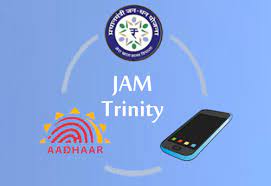India’s efforts to increase the population’s access to formal financial services have been accompanied by numerous regulatory breakthroughs over the past few decades. This required promoting bank nationalization at the beginning of the 1970s and expanding banking accessibility in rural areas.
Utilizing the “Jan Dhan Account-Aadhaar-Mobile” (JAM) trio to assist the needy in receiving welfare payments through Direct Benefit Transfers (DBTs) into their bank accounts was one strategy. By making it easier for people to receive direct deposits from the government, the primary objective was to increase account ownership and usage. The outcome would be a development of the authority monetary framework’s venture into the region of the market it has until now overlooked.
What is the JAM trinity?
The JAM architecture is built on the Aadhaar biometric identifier, the Jan Dhan Yojana’s universal access to basic bank accounts, and India’s rapidly expanding mobile phone network.
The Aadhaar number is used to determine whether citizens are eligible to participate in various government programs and serves as a biometric identification verification. The connecting of Aadhaar numbers to ledgers implies that they may likewise act as an individual’s monetary location, smoothing out the most common way of making electronic government assistance installments.
A person must provide their Aadhaar number and other identifying information in order to participate in the Mahatma Gandhi National Rural Employment Guarantee Scheme (MGNREGS) or the Indira Gandhi National Old Age Pension Scheme (IGNOAPS), for example. Their Aadhaar number would be used to verify their identity, and the bank account associated with that number would receive any benefits due to them.
Jan Dhan Accounts, which are basic checking accounts without extra features, receive government transfers from citizens. Additionally, communicating with them and informing them of the successful transfer of their welfare payment is made possible by the widespread availability of mobile phones.
Benefits of the JAM trinity system
The JAM program’s primary objective was to increase the number of people with bank accounts by providing financial services to those at the bottom of the economic pyramid.
The RuPay debit card and state-run pension and insurance programs were the first to offer Jan Dhan accounts. This consolidation helped the bottom of the pyramid because it made it easier for them to get credit and other financial services.
Physical channels were used in the traditional method of money transfer, which introduced inefficiencies due to the presence of intermediaries. The government and the recipients benefited inefficiently from cash distribution in person.
By allowing direct electronic transfers of funds into bank accounts, the DBT method eliminated the need for intermediary banks. By seeding their Aadhaar numbers into their bank accounts, beneficiaries’ identities can be verified, ensuring that welfare payments are going to the right people.

























